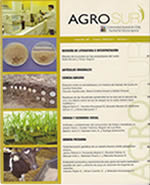Growth dynamic and nutritional quality of a Lolium perenne L. pasture under different defoliation frequencies: spring-summer period
Main Article Content
Abstract
The study was carried out between September 2009 and January 2010 in Valdivia, Chile. Twenty seven mini-swards of Lolium perenne L. cv. Impact were established in 125 L containers (0.181 m2). A complete randomized block design was used. Nine frequencies of defoliation were evaluated,
according to number of leaves per tiller (1- 1.5- 2- 2.5- 3- 3.5- 4- 4.5- 5). Measurements were taken every three days, on marked tillers, to determine leaf appearance, leaf elongation and tiller
appearance. Cumulative growth was measured in each cut and forage was collected for chemical composition analysis. The results were subjected to ANOVA (p<0.05), Waller-Duncan means comparison test and regression analyses were made between defoliation frequency and the evaluated variables. Defoliation interval had no effect (p>0.05) on phyllochron. The differences in GDD varied between 56.1° a 126.8 °C/day for spring and summer, respectively. A lower defoliation frequency
resulted in higher cumulative growth and leaf elongation. Tiller appearance was not affected by the different defoliation frequencies. A more frequent defoliation frequency increased CP, SP, ME and TA, whereas ADF, NDF and WSC were reduced. In conclusion, the phyllochron was independent of the defoliation frequency varying from 8 to 18.3 days, depending on the season (Spring-Summer).

